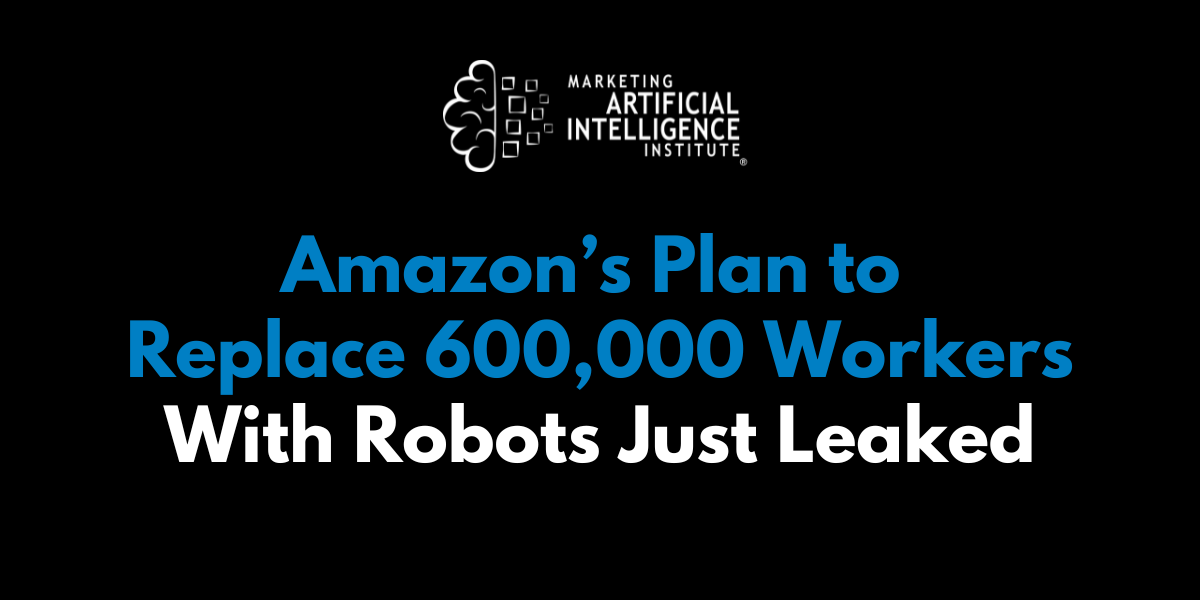Amazon, the second-largest private employer in the United States, is reportedly planning to automate a massive portion of its workforce during the next decade.
Internal strategy documents obtained by The New York Times reveal a far-reaching plan to automate 75 percent of the company's operations. This move could allow Amazon to avoid hiring more than 160,000 new workers by 2027 and more than 600,000 by 2033, even as its sales are expected to double.
And this isn't just a random leak. The newspaper reports these were goals presented directly to the company's board.
To understand what this strategy means for the future of work and the broader economy, I discussed the revelations with SmarterX and Marketing AI Institute founder and CEO Paul Roetzer on Episode 176 of The Artificial Intelligence Show.
A 75 Percent Automation Goal
For anyone who follows Amazon, this strategy, while stunning in scale, isn't surprising in its intent.
“This is Amazon's history. This is what they do,” Roetzer said. “They obviously look for automation. They've been major investors in robotics for the last 15 years or more.”
The company, which has a U.S. workforce of 1.2 million, has an "ultimate goal to automate 75 percent of its operations," according to the documents.
A new warehouse in Shreveport, La., serves as a template for this future. With more than a thousand robots handling most packaging tasks, employment at the facility is already 25 percent lower than it would have been without automation, a figure expected to hit 50 percent as more robots come online.
In a statement, Amazon said the documents were legitimate but "incomplete" and did not "represent the company's overall hiring strategy," according to The Times
If Amazon Does It, Everyone Else Will Follow
The Times article quoted Daron Acemoglu, an MIT professor and Nobel laureate, who noted that "nobody else has the same incentive as Amazon to find the way to automate."
Acemoglu warned that once Amazon works out how to do this profitably, "it will spread to others, too," potentially transforming one of the nation's biggest job creators into a "net job destroyer."
This is the critical ripple effect. Amazon’s moves create a blueprint for every other business dealing with logistics, shipping, and manufacturing.
“If Amazon does it, everybody else will do it in the supply chain,” Roetzer says. “Everybody's going to look at that from a manufacturing operations standpoint: logistics, delivery, transportation.”
The Future of Work: An Engineering Degree?
This strategy raises a critical question about the future labor market: What happens to the hundreds of thousands of workers whose jobs are automated away?
Amazon, which already has one million robots at work globally, has stated it believes the "jobs of the future" will involve caring for these robots. But this implies a massive skills gap.
“The question starts to become, do you need an engineering degree to work at Amazon?” Roetzer said.
While new, higher-paying jobs in robotics and engineering will be created, they are unlikely to absorb the vast number of workers, including seasonal employees, who are displaced.
This disruption isn't limited to warehouses. Roetzer points to the parallel development of autonomous driving—which could impact Amazon's massive delivery fleet—and the rapid advancement of humanoid robots.
“We're talking about some major disruption in the next 10 years,” he said. “When you look at stuff like this, it's not only a possibility, it's a probability that there's some meaningful disruption to an entire workforce.”
"They Are Telling You Point Blank"
The internal documents also revealed a strategy to soften the public perception of this automation push.
Memos reportedly encouraged using terms such as “advanced technology” or “cobot” (collaborative robot) instead of “robot” or “AI.” The company also drafted community outreach plans to sponsor local events and avoid automation talk, aiming to maintain its image as a "good corporate citizen."
While the future economic impact isn't fully knowable, the intent is no longer hidden.
"They're telling you point blank what their plan is," says Roetzer. "And I just want people to think about what do we do if it's true."
Mike Kaput
As Chief Content Officer, Mike Kaput uses content marketing, marketing strategy, and marketing technology to grow and scale traffic, leads, and revenue for Marketing AI Institute. Mike is the co-author of Marketing Artificial Intelligence: AI, Marketing and the Future of Business (Matt Holt Books, 2022). See Mike's full bio.


